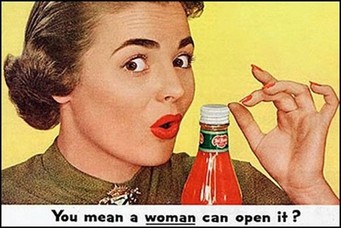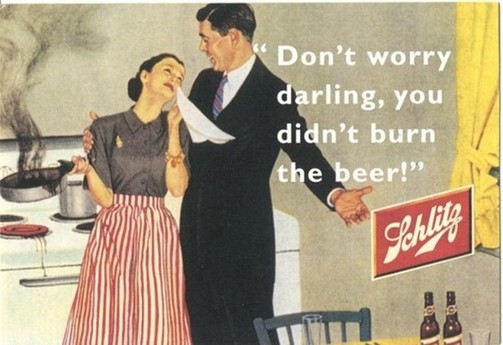HISTORY

SEXISM IN ADVERTISING
Sexism towards women in advertising has always been an issue in the history of American society. Women have always been expected to fill specific gender roles as the cleaning, cooking, or child-bearing sex machine. Today’s society has most certainly evolved to where such discrimination is extremely discouraged and looked down upon. During the 1950s, however, sexism against women was something that was normal and expected by both men and women. Regardless of how insulting or chauvinistic ads were towards women, people were socialized to tolerate and accept the female house-wife stereotype.
Ads in the 1950s most commonly advertised wives being completely controlled and influenced by their husbands, feminine products to help impress their husbands, cleaning products, and endless cooking and references to the benefits of staying in the kitchen. These vintage ads that included phrases such as, “Don’t worry darling, you didn’t burn the beer!,” “Men are better than women!,” and “Christmas morning: she’ll be happier with a Hoover!” not only created a stigma for women in general, but they were shockingly blunt and irrefutably left no room for interpretation.
THE WOMEN'S MOVEMENT
Women’s rights movements originated in the 1800s, but only in the 1960s and 1970s after influence from the Civil Rights Movement did a wave of women’s rights activists successfully gain enough momentum to gain recognition as the true Women’s Movement (Pandhe, 1988). Below are some of the rights women fought for:
o Access to equal educational opportunities
o Equal career opportunities with equal pay.
o Ability to participate in organized sports.
o Freedom of choice (Abortion without interference from men, government, or politics).
o Opportunity to apply for graduate programs at the same rate as men.
o Ample day care for their children in order to allow single mothers to work.
o Creation of women's shelters for abused women and children.
A book called, The Feminine Mystique, written by Betty Friedan in 1963 also had a significant influence on women of that time. In her book, Friedan wrote how she wanted women “to seek new roles and responsibilities, to seek their own personal and professional identities rather than have them defined by the outside, male-dominated society” (Friedan, 1963) Her book was the spark that lit the candle to a social revolution and the Women’s Movement.
Media representations of women was also a topic that was much discussed during the Women’s Movement in the 1960s. Advertisements during this time were depicting women as picture perfect housewives, which became quite damaging to the fragile and impressionable American women. Once the Women’s Movement began, however, magazines, such as Reader’s Digest, Ladies’ Home Journal, Woman’s Home Campaign, and Life Magazine started supporting women’s rights and equality (Walker, 1998).
TRANSFORMATION OF "BEAUTY"
Society’s interpretation of beauty has significantly changed over time and will always continue to change. For example, in the early to mid-twentieth century, women were considered beautiful if they had fair skin and a full, curvy figure. Having tan skin simply meant that you spent too much time outside, which was further associated with the working class (Sebastian, 2008). Having a voluptuous body meant represented a fertile and wholesome woman. As years passed, women gradually became slimmer and darker skinned. In today’s society, beauty is almost the exact opposite as it was in the early twentieth century. Women are socialized to want to have tan skin with a very thin body frame.
Women are not coming up with these beauty and style decisions on their own, however. The media and advertising plays a huge role in influencing what women view as “beautiful”. Flooding women’s brains with the tan, tall, slender bodies of modern models is a tactic the media uses to keep society up with the times. If a certain image is repeated enough through television, printed ads, movies, commercials, billboards, etc., society will accept this image as the norm and copy it (Alice, 2010). In conclusion, as society transforms and changes over time, our image of beauty will subsequently continue to change as well.
Sexism towards women in advertising has always been an issue in the history of American society. Women have always been expected to fill specific gender roles as the cleaning, cooking, or child-bearing sex machine. Today’s society has most certainly evolved to where such discrimination is extremely discouraged and looked down upon. During the 1950s, however, sexism against women was something that was normal and expected by both men and women. Regardless of how insulting or chauvinistic ads were towards women, people were socialized to tolerate and accept the female house-wife stereotype.
Ads in the 1950s most commonly advertised wives being completely controlled and influenced by their husbands, feminine products to help impress their husbands, cleaning products, and endless cooking and references to the benefits of staying in the kitchen. These vintage ads that included phrases such as, “Don’t worry darling, you didn’t burn the beer!,” “Men are better than women!,” and “Christmas morning: she’ll be happier with a Hoover!” not only created a stigma for women in general, but they were shockingly blunt and irrefutably left no room for interpretation.
THE WOMEN'S MOVEMENT
Women’s rights movements originated in the 1800s, but only in the 1960s and 1970s after influence from the Civil Rights Movement did a wave of women’s rights activists successfully gain enough momentum to gain recognition as the true Women’s Movement (Pandhe, 1988). Below are some of the rights women fought for:
o Access to equal educational opportunities
o Equal career opportunities with equal pay.
o Ability to participate in organized sports.
o Freedom of choice (Abortion without interference from men, government, or politics).
o Opportunity to apply for graduate programs at the same rate as men.
o Ample day care for their children in order to allow single mothers to work.
o Creation of women's shelters for abused women and children.
A book called, The Feminine Mystique, written by Betty Friedan in 1963 also had a significant influence on women of that time. In her book, Friedan wrote how she wanted women “to seek new roles and responsibilities, to seek their own personal and professional identities rather than have them defined by the outside, male-dominated society” (Friedan, 1963) Her book was the spark that lit the candle to a social revolution and the Women’s Movement.
Media representations of women was also a topic that was much discussed during the Women’s Movement in the 1960s. Advertisements during this time were depicting women as picture perfect housewives, which became quite damaging to the fragile and impressionable American women. Once the Women’s Movement began, however, magazines, such as Reader’s Digest, Ladies’ Home Journal, Woman’s Home Campaign, and Life Magazine started supporting women’s rights and equality (Walker, 1998).
TRANSFORMATION OF "BEAUTY"
Society’s interpretation of beauty has significantly changed over time and will always continue to change. For example, in the early to mid-twentieth century, women were considered beautiful if they had fair skin and a full, curvy figure. Having tan skin simply meant that you spent too much time outside, which was further associated with the working class (Sebastian, 2008). Having a voluptuous body meant represented a fertile and wholesome woman. As years passed, women gradually became slimmer and darker skinned. In today’s society, beauty is almost the exact opposite as it was in the early twentieth century. Women are socialized to want to have tan skin with a very thin body frame.
Women are not coming up with these beauty and style decisions on their own, however. The media and advertising plays a huge role in influencing what women view as “beautiful”. Flooding women’s brains with the tan, tall, slender bodies of modern models is a tactic the media uses to keep society up with the times. If a certain image is repeated enough through television, printed ads, movies, commercials, billboards, etc., society will accept this image as the norm and copy it (Alice, 2010). In conclusion, as society transforms and changes over time, our image of beauty will subsequently continue to change as well.

